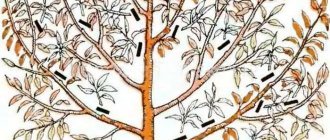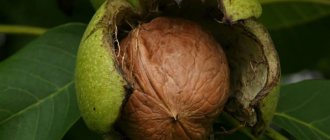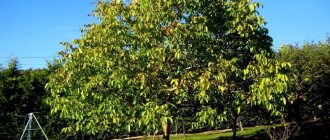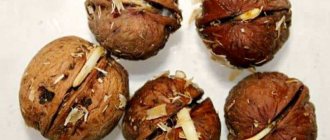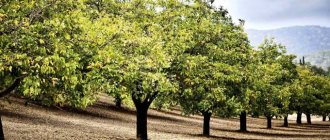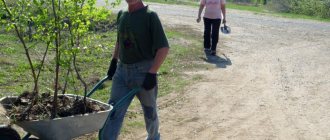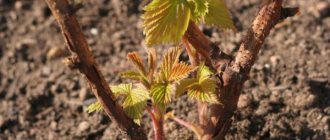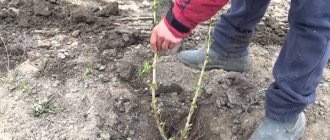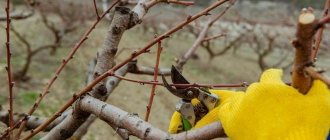What is a permanent transplant and why is it needed?
Transplantation is the transfer of a plant to a new place in compliance with agrotechnical measures. This procedure is necessary for the tree to create a powerful root system, and in the future - better fruiting.
It is best to replant a young tree up to 4 years old, since a large adult plant can damage the root system, and it is much more difficult for it to take root.
What else do you need to know?
In order for the transplanted tree to quickly take root in a new place, and in the future to grow quickly and produce a good harvest, we recommend that you follow the following tips:
- Plant the tree at the level at which it grew. If you ignore this condition, the tree will grow very poorly, and most importantly, you will have to wait a very long time for fruits.
- Planting should be done at such a depth that the root collar is flush with the soil. Make a small mound and place the root system. After the first watering, it will occupy the same level with the soil.
- During dry periods, water the soil generously as... walnuts do not tolerate drought. Timely moistening of the mail will ensure that there are no problems with the tree.
- For a good harvest, the tree must be fully pollinated. To do this, organize the planting of several trees near the walnut. The wind can carry pollen over a distance of 300 m.
- The roots of the tree should not be close to the surface, because the seedling may dry out.
Now we know when it is possible to transplant seedlings and what recommendations should be followed so that the tree grows well and brings a rich harvest.
When the procedure is carried out: time of year and age of the plant
When replanting a nut, the gardener must first of all be guided by the climatic characteristics of his region. Transplantation is carried out in the warm season, when the air temperature is at least +10°C. It is advisable to replant the seedling when it is still dormant, in spring or autumn.
Important!
Summer is an undesirable time to transplant walnuts. It is not recommended to disturb the plant during this period.
But if suddenly an urgent need arises, follow the rules for carrying out the transplant process in the summer:
- The tree must be no older than 5 years.
- The procedure is carried out early in the morning or late in the evening.
- Prepare a planting hole in advance, into which the dug plant is quickly transferred.
- Dig up the nut with a large lump of damp soil.
- Before the procedure, 12-14 hours before, the tree is watered abundantly.
- After replanting, moisten the soil abundantly again and mulch the tree trunk circle to maintain moisture.
Tips and after care
You cannot ignore caring for walnuts after transplantation. This way it will take root faster and bear fruit well.
- Manure and straw can be spread around the planted tree - the nitrogenous composition will contribute to faster adaptation
- The soil needs to be mulched
- During the hot period, we must not forget about the need for regular watering. Drought can easily kill a seedling.
- It is important that the tree is well pollinated. For this purpose, several more trees are planted nearby.
- It is important to monitor the roots. Closely located roots can cause the death of a walnut.
By following these simple tips, even an amateur gardener can easily replant a walnut on his plot.
Consequences of failure to meet deadlines
Spring and autumn are the best times for replanting. Failure to meet deadlines can negatively affect the life of the walnut tree.
Consequences of untimely transplantation:
- rotting and death of the root system;
- decrease in yield;
- high susceptibility to diseases and pests;
- weak growth, stunting;
- death of the tree.
Attention!
The walnut has an interesting symbiosis: mushrooms live on its roots, which nourish the root system and contain nutrients beneficial to the tree. If this union is disrupted during transplantation, the tree may even die.
Tree planting process
Seeds or seedlings are used for planting. When choosing a seed variety, look for options that are already adapted to the weather conditions of your region. A freshly picked green or yellow nut is perfect for planting. It is important that it does not have dents and is round in shape.
Mid-autumn is the best time to collect nuts. During this period, the tree actively bears fruit, dropping ripe fruits. It is recommended to plant walnuts in the fall after harvesting.
The fruit should be peeled from the outer shell so that the fruit germinates faster. Be careful not to deform the inner shell during cleaning.
There is one way to check the germination of seeds:
- Place the fruits in a container of water.
- For planting, select fruits that have sunk: they have a solid core. Such a fruit has the maximum chance of producing a healthy sprout.
- Do not forget about stratification (the fruit is placed at a temperature of 1–4 °C for 4 months).
The best solution is to plant walnuts directly in the ground in the fall.
Remember, if you live in an area where winters are cold, then the fruit should be planted to a depth of at least 20 cm, which will prevent spoilage of the fruit during severe frosts.
The health of the future tree will depend on how correctly you plant the walnut. Seedlings are planted in the spring, when frosts have passed and warm weather has set in. Two-year-old seedlings are required for planting. The thickness of the seedling must be at least 1 cm. Digging is done as delicately as possible so as not to disturb the root system.
How to properly prepare a new place?
First of all, you need to choose the right place. The walnut should not be located near buildings, since subsequently, as it grows, its powerful root system can damage the house, destroying the foundation. Shadow also does not contribute to good growth and development of the tree; it needs light. Therefore, choose a sunny, open place on the site.
The size of the planting hole depends on the age of the plant and the composition of the soil. In fertile soil, the size of the hole is 50-60 cm in depth and width. For other soils, the size should be increased to 1 meter. The older the tree, the more space its roots need. In dense soil at the bottom of the hole there must be good drainage, so in this case the hole is also increased in size.
Advice
The drainage layer must be at least 16cm. Walnuts thrive best in rich, chernozem soils.
Ammophos can be used as a fertilizer during transplantation. It needs to be poured in a heap at the bottom of the hole, in the amount of 1 kg.
Importance and timing of transplantation
The fact is that the walnut has a very powerful and spreading root system. It is dangerous for nearby buildings. In the first years of life, the tree develops mainly a taproot and goes deep, but after 3 years, the lateral roots also begin to actively participate in growth. Thus, in an adult 5-year-old nut, the taproot goes 1.5 m deep, but the lateral ones, strongly “spreading” to the sides, reach a diameter of about 2 m, while they are located at a shallow depth - up to 0.5 m. And here the tree begins to pose a serious threat to the foundation. The problem is that in this case it is almost impossible to replant the tree and in order to save the building you will simply have to destroy the fruit-bearing crop.
The crown of a tree located near the house causes less damage, but, nevertheless, during the season of active leaf fall, cleaning them can also cause inconvenience. Therefore, it is worth replanting the nut in a timely manner and thereby avoiding a number of problems.
Expert opinion on the question “is it possible to replant a walnut?” unanimous: not only possible, but also necessary. This should be done when the tree has not yet reached 4 years of age. At the same time, you should be extremely careful when digging and transporting. Damaged roots will result in:
- reduction in harvest volumes;
- violation of the protective functions of the tree - it will be susceptible to negative external factors and diseases;
- death of culture.
As for specific recommendations regarding the season when it is worth replanting walnuts, it is best to choose a warm spring or autumn day.
Transplantation in spring
In order for a walnut transplant to be successful in the spring, it is necessary to take into account the temperature regime. Of course, for the south, where already the second half of April is characterized by persistently high thermometer readings, the normal time for planting will be the end of April - the beginning of May. But in regions where frosts may linger, it is better to replant walnuts in the spring by the end of May. However, if you make small observations of the temperature and make sure that the average daily temperature no longer falls below +10 ̊C, then you can safely replant.
in autumn
Not all regions can afford to replant a nut in the fall. So, it is better for residents of the northern part to postpone this idea until spring, because the persistent cold that comes with the first days of September will simply kill the seedling . In warm regions, planting in the ground is carried out while the average daily temperature outside remains at least +10 °C (from the 2nd half of October to the 2nd half of November).
At what time of day and in what weather can this be done?
Certain conditions that will be met will help you grow a healthy, strong tree:
- Rapid adaptation is facilitated by planting in the afternoon, when biological processes in the tree slow down.
- The transplant is carried out either in the spring, before the buds open, or in the fall, before the onset of frost.
- The weather should be warm, temperature at least +10°C.
- The day before transplanting to a new place, water the nut generously.
- Before transferring, the roots are trimmed slightly, maintaining about 40 cm in length.
Description and characteristics
Walnut is a hardy tree up to 25 m high, the trunk diameter can reach 7 m. The crown is wide, spreading, with complex oval-shaped leaves. It can hardly withstand frosts below -25°C. At latitudes from St. Petersburg to Voronezh it does not completely freeze out, but it does not grow to its full potential. Here the walnut rarely reaches a height of 4 m. However, this is quite enough to obtain harvests, even if not annually.
The seeds of the plant are nuts with high taste and nutritional value. The leaves of this tree are also useful: they have long been used as a wound-healing agent. Nut shells also deserve attention: they are in demand in various industries.
Autumn or spring - which is better?
The advantages and disadvantages of autumn and spring work can be seen from the comparative table.
| Comparison criterion | Spring. | Autumn. |
| Time | April-May, until the buds swell. | October-November, until frost. |
| The soil | Must be completely thawed. | Not frozen, soft. |
| Temperature | Not less than +10°С. | Not less than +10°С. |
| Region |
| Better suited for the southern regions of the country. |
Control of diseases and harmful insects
To ensure that the walnut is protected from attack by pests and infections, it is sprayed with special solutions twice a year. The first treatment is carried out before fruiting, the second - in the fall, after the leaves fall. In the spring, before sap flow begins, the crown is treated with a solution of Bordeaux mixture or copper sulfate. The same solutions are used to treat the tree in the fall, after the leaves have fallen.
Frequent diseases that infect walnuts are: bacteriosis, brown spot, root canker, fire blight. In all cases, spots appear on the leaves, they dry out, curl and fall off. The yield decreases, and in some cases the situation threatens the complete death of the plant. Treatment is carried out with drugs such as Vectra and Strobi.
The most commonly attacked pests are: American white butterfly, warty mite, nut moth, moth and aphid. Such drugs as Lepidotsid, Dendrobacillin, Aktara, Akarin, Decis, Actellik help to cope with insects.
Step-by-step instructions for the procedure
in autumn
The practice of gardeners shows that trees planted during leaf fall take root best. In order to properly transplant a nut, the stages of this procedure have been developed.
- Dig a hole of the appropriate size; the larger and older the seedling, the larger it should be.
- A drainage layer (fragments of bricks, pottery, small stones), ammophos, and then some earth are poured onto the bottom of the pit.
- Install the seedling, carefully straightening its root system.
- Add soil so as not to cover the grafting site.
- Carefully twist the plant so that the earth crumbles and there are fewer voids.
- Then the soil is compacted and covered with mulch.
- Water at the rate of 6 buckets of water per plant.
Important!
Trees transplanted in the fall may freeze during frosts. Therefore, it is important to plant them as deep as possible.
The following video shows how to properly replant a plant in the fall:
in spring
Spring transplantation of a walnut tree has the following stages:
- The tree is watered abundantly several hours before transplanting. The soil should be saturated with water to make it easier to free the roots.
- The seedling is removed and the roots are trimmed a little. The sections are treated with ash.
- Cover the plant with fertile soil to half the depth of the hole. The tree is placed in the middle so that it is located at the same height as it grew.
- Fill the hole completely with soil and water it abundantly.
Mulching is used to ensure that the soil does not dry out and maintains maximum moisture.
Tree transplant
You can replant a nut when its age has reached 2–3 years. Transplantation is carried out in autumn or spring. The difference will be that trees transplanted in the fall are at risk, and their roots may freeze. They should be planted as deep as possible. It is important to water spring seedlings in a timely manner.
The seedling should be transplanted to a permanent place, so choose the area responsibly. The root collar of the plant is very powerful, so it cannot grow next to other crops. Places near fences and buildings are not suitable.
The ground for nuts should be fertilized with humus, ash or other fertilizer options. The composition is thoroughly mixed with the soil and then placed in the hole. There will be enough nutritional components for the first year, and over time the tree will get stronger and will feed itself from the soil.
The day before transplanting the nut, the seedling should be dug up with soil, and the roots should be trimmed so that their length does not exceed 35 cm. The cut areas should be thoroughly coated with clay.
Transplanting seedlings and adult plants (from 3 years old) - what is the difference?
Transplanting a seedling is slightly different from planting an already mature nut. The older the tree, the more difficult it is to plant it in a new place.
- A seedling is considered to be a young tree 1-2 years old. Before transplanting, it is watered abundantly a day before, carefully removed from the ground, the roots are trimmed and transferred to a new hole.
- From the age of 3, a walnut is considered an adult tree. It is more difficult for it to take root in a new place, since it has a developed powerful root system, and it is difficult not to damage it during transplantation. Injuries resulting from this can even lead to the death of the plant.
- To transplant an adult nut, step back 1 meter from the trunk and dig up the plant, taking it out along with the earthen lump. Before this, like the seedling, it is watered abundantly.
- Carefully remove, quickly transfer to an already prepared hole and water generously.
- After transplantation, both the seedling and the mature tree are tied to a peg to make the plant more stable. Under the influence of winds and uncompacted soil, it can tilt strongly to the side.
- It is better not to replant walnuts older than 5-6 years. He has virtually no chance of normal growth and development.
How to transplant walnut seedlings
When choosing a permanent site for seedlings grown in the nursery, you need to take into account some features so that in the future you do not have to uproot the adult tree. Firstly, young plants should not be planted near buildings, which over the years will hinder the development of a powerful root system.
Secondly, keep in mind that the walnut is a light-loving plant, so it needs a spacious, well-lit area, where, moreover, the tree will bear fruit better and suffer less.
Choose 1-2 year old plants as seedling material. It is advisable to replant the nut as early as possible, since every year its root system goes deeper into the ground and digging it out without damage will be problematic.
The day before transplanting, the seedlings need to be watered, and during the process, carefully remove them along with the earthen lump and pinch (shorten) the root tip so that its length is no more than 35 cm. This technique will allow the tree to develop better - the crown will be lower and thicker .
Did you know? There is an opinion among experienced gardeners that when planting a young nut, you need to place a large flat stone under the central root - this way fruiting will occur faster.
The planting pit is prepared in advance. On average, for a young seedling its dimensions (diameter and depth) should be about half a meter, but the parameters depend on the individual size of the rhizome with an earthen lump, which can be large. Please note that a drainage layer and fertilizer will need to be placed at the bottom of the hole.
If you are planting a young nut on heavy or, conversely, poor sandy soil, you can dig a hole up to 1 m deep, and when planting, use only the top layer of soil mixed with fertilizers.
Drainage about 15 cm thick is formed from gravel, crushed stone or broken brick. To form fertile soil with which you will fill the seedling, mix part of the topsoil with humus and compost (5 kg of each), add 2 kg of superphosphate, 800 g of potassium chloride and up to 2 kg of wood ash. This assortment of fertilizers will provide the soil with nutrients for the next few years.
The seedling is placed in the center of the hole so that the root collar is a couple of centimeters above the soil level, the roots are straightened, and covered with half-prepared soil. Now the planting needs to be watered abundantly (10–15 liters) and the remaining space should be filled, lightly compacted.
Again you need to water with the same amount of water and mulch the soil with compost or sawdust. You need to drive stakes from different sides and tie a young tree to them so that it does not bend from the soft, not yet sufficiently compacted soil and strong winds.
When does a young nut begin to bear fruit?
How many years will it take for a nut to bear fruit depends on many factors. A tree grown from a fruit begins to produce a harvest in the 7-9th year. With proper care, the first nuts will appear on purchased seedlings already in the 3-4th year. To increase productivity in the future, the first 3-4 years of growth should be monitored so that the tree gains sufficiently branched green mass. If few side branches are formed, then their tops are cut off into 2-3 buds.
Maturation period
Nuts begin to ripen at different times. The variety plays a decisive role:
- Harvesting of early ripening crops begins in early September;
- mid-season varieties begin to ripen at the end of September;
- Late walnut varieties ripen in mid-October.
The climate of the region also plays an important role. In places with cold weather conditions, fruit ripening is delayed by 2-2.5 weeks.
Signs of fruit ripeness
In order for the harvest to be stored for a long time, it must be harvested on time. Signs of fruit ripening, which begin to appear as early as August, include:
- shedding of nuts from branches;
- darkening and cracking of the green shell of the nut;
- The nut shell takes on a brown tint.
The harvest does not ripen evenly, so the nuts are collected in several stages.
Harvesting Rules
When can you start harvesting? Nuts begin to ripen towards the end of summer, beginning of autumn. Those fruits whose green skin has begun to crack are suitable for harvesting for storage. It is not recommended to collect fruits from the tree, since they do not contain the entire supply of useful components. It happens that a nut is ripe, but does not fall from the trees. Therefore, a long pole comes to the rescue, which is used to carefully hit the branches. The collected nuts are cleaned of pericarp and other debris.
